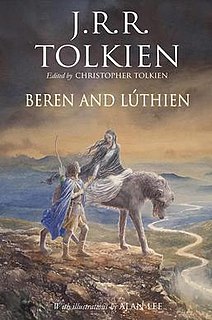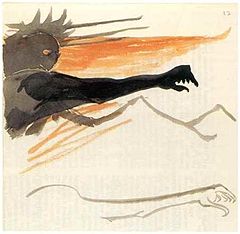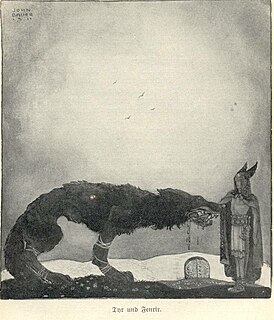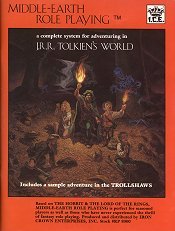The Nazgûl, introduced as Black Riders and also called Ringwraiths, Ring-wraiths, Dark Riders, the Nine Riders, or simply the Nine, are fictional characters in J. R. R. Tolkien's Middle-earth legendarium. They were nine men who succumbed to Sauron's power and attained immortality as wraiths, servants bound to the power of the One Ring and completely under the dominion of Sauron. They are first mentioned in The Lord of the Rings, originally published in 1954–1955.
Radagast the Brown is a fictional character in J. R. R. Tolkien's Middle-earth legendarium. He is one of the Istari, also known as "Wizards", who were sent by the angelic Valar to aid the Elves and Men of Middle-earth in their struggle against the Dark Lord Sauron. Radagast appears in Unfinished Tales, and is mentioned in The Hobbit, The Lord of the Rings, and The Silmarillion.
The Rings of Power in J. R. R. Tolkien's Middle-earth legendarium are magic rings created by Sauron or by the Elves of Eregion under Sauron's tutelage. Sauron intended three of the rings to be worn by Elves, Seven by Dwarves, Nine by Men, and one, the One Ring, by Sauron himself in Mordor.
Glorfindel is a fictional character in J.R.R. Tolkien's Middle-earth legendarium. He is introduced in various material relating to the First Age of Middle-earth, including The Silmarillion. The name is also used for a character in The Lord of the Rings, which takes place in Middle-earth's Third Age. In late writings, Tolkien works out how the two characters were one and the same, though this is not evident from the published versions of The Silmarillion and The Lord of the Rings.
Celeborn is a fictional character in J.R.R. Tolkien's Middle-earth legendarium. Celeborn is an Elf, and the husband of Galadriel. He appears in The Lord of the Rings as the Lord of the Galadhrim, and co-ruler along with Galadriel of Lothlórien. He was the father of Celebrían, and thus the grandfather of Arwen Evenstar and her older brothers Elladan and Elrohir. He was also a kinsman of the First Age Elven King Thingol. Celeborn means "(tall) silver tree" in Tolkien's invented language of Sindarin.
In J. R. R. Tolkien's legendarium, Lothlórien or Lórien is the fairest realm of the Elves remaining in Middle-earth during the Third Age.
The War of Wrath, or the Great Battle, is the final war against Morgoth at the end of the First Age. It is a key plot development in J.R.R. Tolkien's legendarium,

In J. R. R. Tolkien's fictional universe of Middle-earth, the eagles were immense flying birds that were sapient and could speak. Often emphatically referred to as the Great Eagles, they appear, usually and intentionally serving as agents of eucatastrophe or deus ex machina, in various parts of his legendarium, from The Silmarillion and the accounts of Númenor to The Hobbit and The Lord of the Rings. Just as the Ents are guardians of plant life, the giant eagles are the guardians of animal life.
Silvan are a type of Elves in J.R.R. Tolkien's fictional universe of Middle-earth, mainly the Elves of Mirkwood and Lothlórien. They are commonly known as Wood-elves.

The tale of Beren and Lúthien, told in several works by J. R. R. Tolkien, is the story of the love and adventures of the mortal Man Beren and the immortal Elf-maiden Lúthien. Tolkien wrote several versions of their story, the latest in The Silmarillion, and the tale is also mentioned in The Lord of the Rings. The story takes place during the First Age of Middle-earth, about 6,500 years before the events of The Lord of the Rings.
Tolkien's legendarium is the body of J. R. R. Tolkien's mythopoeic writing that forms the background to his The Lord of the Rings, a high fantasy novel which is widely considered to be his magnum opus. Tolkien worked and re-worked the components of his legendarium throughout his adult life, a period of more than 50 years; the earliest drafts, published in The Book of Lost Tales (1983), date to 1916, with poems, paintings and nomenclature related to it going back to 1914.
The cosmology of J. R. R. Tolkien's legendarium combines aspects of Christian theology and metaphysics, mythology and pre-modern cosmological concepts in the flat Earth paradigm with the modern spherical Earth view of the solar system.
In J. R. R. Tolkien's fictional Middle-earth, much of the history of the three ages of his legendarium are concerned with wars and the battles and armies of those wars.
Aragorn II, son of Arathorn is a fictional character from J. R. R. Tolkien's legendarium. He is one of the main protagonists of The Lord of the Rings. Aragorn was a Ranger of the North, first introduced with the name Strider at Bree, as the Hobbits continued to call him throughout The Lord of the Rings. He was eventually revealed to be the heir of Isildur and rightful claimant to the thrones of Arnor and Gondor. He was also a confidant of Gandalf and an integral part of the quest to destroy the One Ring and defeat the Dark Lord Sauron.
Elrond Half-elven is a fictional character in J. R. R. Tolkien's Middle-earth legendarium. He is introduced in The Hobbit, and plays a supporting role in The Lord of the Rings and The Silmarillion.
Legolas is a fictional character in J. R. R. Tolkien's legendarium. He is a Sindarin Elf of the Woodland Realm and one of nine members of the Fellowship of the Ring.

Sauron is the title character and main antagonist of J. R. R. Tolkien's The Lord of the Rings.

The Silmarillion is a collection of mythopoeic works by English writer J. R. R. Tolkien, edited and published posthumously by his son, Christopher Tolkien, in 1977, with assistance from Guy Gavriel Kay. The Silmarillion, along with J. R. R. Tolkien's other works, forms an extensive, though incomplete, narrative that describes the universe of Eä in which are found the lands of Valinor, Beleriand, Númenor, and Middle-earth, within which The Hobbit and The Lord of the Rings take place.











